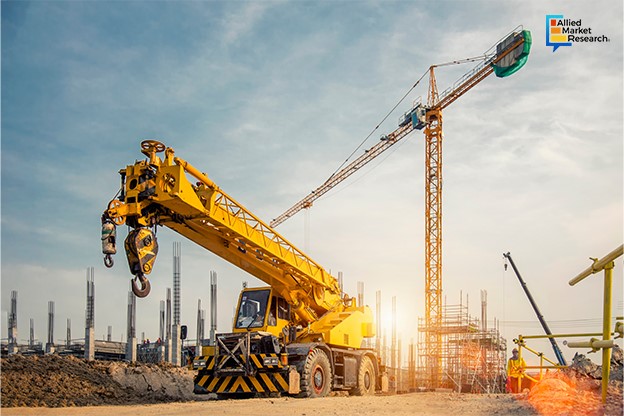How Are Construction Cranes Shaping the Modern Infrastructure Industry?

16 Feb
2024
Today, the use of cranes in construction and infrastructure industries is a common phenomenon. Used as a water lifting device in ancient Mesopotamia, this machine has evolved tremendously in the past two thousand years. The modern construction crane was first developed during the Industrial Revolution, which like the steam engine, was powered by steam. Just like automobiles, internal combustion engine cranes and electric cranes came up in the late 19th and 20th century.
Why are construction businesses increasingly relying on mobile cranes?
Mobile cranes, as the name suggests, are cranes controlled using cables and are mounted on carriers or crawlers, so that they can be transported. The rising applicability of mobile cranes can be proven by the fact that several types of mobile cranes have come up in the industry which are suited for different construction projects. One of the most widely used mobile cranes is the crawler crane. These cranes, though mobile, are extremely bulky, which is why they are generally used for long term projects. Moreover, since these machines have rubber tracks instead of wheels, they stand firm even on soft grounds without sinking. Their ability to work efficiently on uneven terrain is probably their biggest strength.
As opposed to crawler cranes, which are perfect for uneven or soft terrains, floating cranes are primarily used for construction and infrastructure projects on open seas. Due to the nature of work they perform, floating cranes are sometimes also called crane ships. The biggest employer of this type of mobile crane is the oil and gas exploration industry, which needs such machines on offshore oil rigs.
Rough terrain cranes are another type of mobile cranes; they are similar to crawler cranes, just that they have four large tires instead of rubber tracks. Due to this difference, instead of long-term projects on rough terrains, these cranes perform pick and carry operations. Thus, their mobility on rough terrain is much better than any other mobile cranes.
Truck-mounted cranes and carry deck cranes are rather new types and are chiefly known for their versatility and mobility. Apart from acting as cranes, they can even carry additional equipment which is required at the project site. These cranes are generally used for maintenance work and inspection jobs. In certain cases, they are also used in the construction of bridges.
Why should your business invest in the fixed cranes segment?
It wouldn’t be an understatement to say that the modern construction and infrastructure industry relies on the efficient nature of fixed cranes. Tower cranes, for instance, are the most commonly used machines in the construction of tall buildings and skyscrapers. The base of the tower crane is concrete which keeps it fixed to the ground, while the operating cab controls the entire crane. The height of the tower crane is increased parallelly as the skyscraper is being built. The slewing unit, which rotates the crane, sits on the top of the crane and aids in lifting heaving materials atop the building.
Bridge or overhead crane is another popular type of fixed crane. Known for their stability, reliability, and efficiency, overhead cranes are specially designed for industrial environments and factory setups. These cranes can be further divided into two subtypes- gantry and jib cranes. While gantry cranes are primarily used on docks and ports for loading/unloading of cargo, jib cranes are used for industrial lifting. The massive demand for overhead cranes is expected to help the overhead travelling crane segment to gather a revenue of $2,006.3 million by 2032.
Crane technologies that will help to modernize your business
R&D activities in the cranes industry are mainly aimed at making cranes more compact and energy efficient. Compact and lighter cranes provide more flexibility and have improved lifting ability, owing to reduced structural stress. The growing focus on energy efficiency is on account of the rising criticism of the construction industry for its huge contribution to carbon emissions. Hence, technologies such as variable frequency drives and regenerative braking devices have been developed that bring down the energy consumption of cranes drastically.
Even the power management systems have evolved significantly which further reduces carbon emissions. Integration of smart crane panels in the crane machinery is another important development which helps crane operators detect and locate problems in the crane's functioning.
To sum it up, cranes are among the most important machinery in the construction industry. Both mobile and fixed cranes have evolved considerably in the past few years with various types of cranes coming up in both the categories. Innovations in crane technology such as smart crane panels and regenerative braking systems are expected to drive the industry forward in the near future.
For tips and suggestions on how to capitalize on the opportunities presented by the cranes industry, talk to our experts today!

Akhilesh Prabhugaonkar
Author's Bio- Akhilesh Prabhugaonkar holds a bachelor’s degree in Electronics Engineering from the reputed Vishwakarma Institute of Technology. He has a special interest in the fields of forensics, world history, international relations and foreign policy, sports, agriculture, astronomy, security, and oceanography. An ardent bibliophile and melophile, Akhilesh loves to write on topics of his interest and various other societal issues. This love for writing made him enter the professional world of content writing and pursue his career in this direction.
Hydraulic Pumps: 4 Emerging Trends Your Business Should Adopt to Stay Ahead in the Industry
Avenue: Entire Library membership of Allied Market Research Reports at your disposal
- Avenue is an innovative subscription-based online report database.
- Avail an online access to the entire library of syndicated reports on more than 2,000 niche industries and company profiles on more than 12,000 firms across 11 domains.
- A cost-effective model tailored for entrepreneurs, investors, and students & researchers at universities.
- Request customizations, suggest new reports, and avail analyst support as per your requirements.
- Get an access to the library of reports at any time from any device and anywhere.
Related Post
-
How are Submarine Cables Transforming Global Connectivity with Enhanced User Experience?
-
Endoscopy Procedures: Transformations in Techniques and Applications
-
AI-Powered Video Analytics: How the Product Actually Works for enterprises
-
Painting Robots: Transforming Precision Coating and Creative Applications
-
Innovations in Pharmacovigilance Systems Advancing Patient Safety
-
Understanding Edge Security: Keeping Data Safe Near the Source
-
Exploring the Use and Advancements of 3D Laser Scanners in Professional Applications
-
Reinforcing Industrial Controls with Smarter Tools and Training








